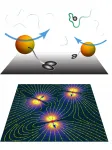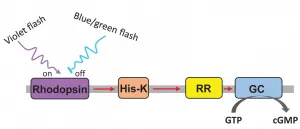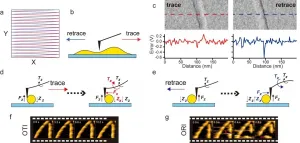NIST develops privacy-preserving 'encounter metrics' that could slow down future pandemics
2021-03-29
(Press-News.org) When you bump into someone in the workplace or at your local coffee shop, you might call that an "encounter." That's the scientific term for it, too. As part of urgent efforts to fight COVID-19, a science is rapidly developing for measuring the number of encounters and the different levels of interaction in a group.
At the National Institute of Standards and Technology (NIST), researchers are applying that science to a concept they have created called "encounter metrics." They have developed an encrypted method that can be applied to a device such as your phone to help with the ultimate goal of slowing down or preventing future pandemics. The method is also applicable to the COVID-19 pandemic.
Their research is explained in a pilot study published in the Journal of Research of NIST.
Encounter metrics measure the levels of interactions between members of a population. A level of interaction could be the number of people in a bathroom who are talking to each other or a group of people walking down a hallway. There are numerous levels of interactions because there are so many different ways people can interact with one another in different environments.
In order to mitigate the spread of an infectious disease there is the assumption that less communication and interaction with people in a community is essential. Fewer interactions among people means there is less of a chance of the disease spreading from one person to another. "We need to measure that. It's important to develop technology to measure that and then see how we can use that technology to shape our working environment to slow future pandemics," said NIST researcher René Peralta, an author of the NIST study.
Picture two people walking from opposite ends of a hallway who meet in the middle. To record this encounter, each person could carry their own phone or a Bluetooth device that broadcasts a signal as soon as the encounter occurs. One way of labeling this encounter is through the exchange of device IDs or pseudonyms. Each device sends its own pseudonym that belongs to the device itself. The pseudonyms could be changed every 10 minutes as a way to promote the privacy of the person's identity.
However, another way of labeling the encounter between two people is through a random number that is not linked to the device each person carries. This is what the researchers call an "encounter ID." Peralta developed an encrypted system that uses encounter IDs to not only measure the encounter between two people but to strengthen the privacy of the identities of the two people from third parties.
Current approaches for mitigating the spread of infectious disease in a population include exposure notification systems, also known as contact tracing, that rely on the pseudonyms. These systems are currently used on smartphones as a way to digitally track if a person comes into contact with someone who has contracted COVID-19. This can help health officials mitigate the spread of the disease by isolating individuals at risk of infecting others.
But the benefit of the NIST method that uses encounter IDs is its promotion of privacy. By labeling each encounter with a random number and not linking the encounter to the device the person is carrying, this makes it much harder for a cyber attacker to obtain that user's identity.
The target audience for this approach would be for a smaller population in a controlled setting like NIST's campus or nursing homes, said NIST researcher Angela Robinson, also an author of the new paper. "We are advancing a different approach to contact tracing using encounter metrics."
Gathering these measurements of how individuals interact with one another can help with better understanding ways of modifying working environments, such as altering building layouts and establishing mobility rules, so as to slow the spread of disease. These architectural changes though are part of a longer-term goal. "Encounter metrics will give health experts and officials more tools to understand interactions of people and infection events," said Peralta.
Through a broader initiative at NIST in which various groups met and discussion occurred to help address the COVID-19 pandemic, Peralta and Robinson collaborated with NIST researcher Sae Woo Nam, who developed a NIST prototype Bluetooth device that uses the cryptographic system developed by Peralta.
The device is slightly smaller than the size of a playing card and can be easily worn around a person's neck or stored in their pocket. It has a sensor to detect a Bluetooth signal and the duration and strength of the signal. The strength of the signal is used to approximate the distance between two individuals. So, if the signal is weaker, one can conclude that the person is following proper social distancing guidelines and is more than 2 meters (6.56 feet) away.
The NIST prototypes rely on ultrasonic ranging where the device transmits a sound wave and researchers can measure the time it takes for the sound wave to reflect off an object and back to the origin. This means that the reflection time is proportional to the distance that the target object is from the source, in this case the device. Ultrasonic ranging allows for a more accurate determination of distance between two people compared to relying solely on the Bluetooth signal.
Researchers also propose an alternative protocol to current approaches for contact tracing using their method of encounter IDs. The alternative proposal follows three parts: reporting, server storage and risk exposure notification. A person who is diagnosed with COVID can voluntarily and anonymously send their encounter IDs to a central server. The server then maintains a running window of all the reported encounter IDs. Lastly, every day each person participating in contact tracing performs a two-party encrypted computation with the server to get the number of encounter IDs that are both in their list and the server's. That number is the person's measure of risk.
It's important to note that this approach relies on each participant being honest or a good actor when sending their encounter IDs. More detailed information on the approach can be found in the paper.
As for next steps, NIST researchers hope to expand beyond the NIST community to work with the larger research community to invest in privacy-preserving encounter metrics. They also aim to further develop the techniques that are already in place to see how they will hold out in scenarios where there are actual malicious threats. To learn more about other research projects addressing the COVID-19 pandemic that are currently underway at NIST, check out the NIST and COVID-19 web portal.
INFORMATION:
[Attachments] See images for this press release:

ELSE PRESS RELEASES FROM THIS DATE:
2021-03-29
A drop of food coloring slowly spreading in a glass of water is driven by a process known as diffusion. While the mathematics of diffusion have been known for many years, how this process works in living organisms is not as well understood.
Now, a study published in Nature Communications provides new insights on the process of diffusion in complex systems. The result of a collaboration between physicists at Penn, the University of Chile, and Heinrich Heine University Düsseldorf, this new theoretical framework has broad implications for active surfaces, such as ones found in biofilms, active coatings, and even mechanisms for pathogen clearance.
Diffusion is described ...
2021-03-29
BUFFALO, N.Y. - Bullying at boarding schools has a negative impact on students' emotional health, but for male students, having a school staff member to rely on for support may mute the harmful effects of bullying, according to a new University at Buffalo study. Support networks did not have the same effect for female students, the researchers say.
The study, recently published in School Psychology Review, is one of few to examine the impact of bullying at boarding schools, which provide a unique environment where most students live on school grounds, away from their families. It is also one of the first studies to observe the effects ...
2021-03-29
Climate labels informing us of a meat product's carbon footprint cause many people to opt for climate-friendlier alternatives. This applies to people who are curious about a product's carbon footprint, as well as to those who actively avoid wanting to know more. The finding is published in a new study from, among others, the University of Copenhagen. As such, climate labeling food products can be a good way of reducing our climate footprint. But according to the researcher behind the study, labels must be obligatory for them to be effective.
Certain situations exist where we humans strategically avoid greater knowledge and more information - a phenomenon known as "active information avoidance". ...
2021-03-29
The unicellular green alga Chlamydomonas reinhardtii has already given research a massive boost: One of its light sensors, channelrhodopsin-2, founded the success of optogenetics about 20 years ago.
In this technology, the alga's light sensor is incorporated into cells or small living organisms such as threadworms. Afterwards, certain physiological processes can be triggered or stopped by light. This has already led to several new scientific findings, for example on the function of nerve cells.
Now the green alga Chlamydomonas is once again setting an accent. Once again, it is its light sensors, ...
2021-03-29
High-speed atomic force microscopy (HS-AFM) is an imaging technique that can be used for visualizing biological processes, for example the activity of proteins. Nowadays, typical HS-AFM frame rates are as high as 12 frames per second. In order to improve the capabilities of the method, so that it can be applied to an ever expanding range of biological samples, better video rates are needed, though. Moreover, faster recording times imply less interaction between the sample and the probe -- a tip scanning the sample's surface -- making the imaging ...
2021-03-29
A team of researchers, led by the Instituto de Ciencias del Patrimonio (Incipit-CSIC) and the Instituto de Astrofísica de Canarias (IAC), in collaboration with the team from the Arqueological Zone of Caral (Perú) led by Dr. Ruth Shady Solís, has established the relation between the position of the monuments of the Supe Culture (Perú), their orientations, and some astronomical and topographic features, which opens the way to the analysis of the way the inhabitants of this valley conceived space and time 5000 years ago. The results of the study have just been published in the journal Latin American Antiquity.
The valley of the river Supe in Perú contains the first evidence for city building in the Americas. In recent decades in this valley and ...
2021-03-29
Next-gen electronics is envisioned to be non-rigid, component-free, flexible, bendable, and easily integrable with different objects.
Direct-write printing techniques provide unique opportunity to enable this vision through use of nanomaterial so-called functional inks, that can be tailored to add desired functionalities on various flexible substrates, such as textiles or plastic.
The technology, known as Printed Electronics (PE), has been known for decades, but has recently gained considerable attention due to innovation in material inks, process technology and design revolution.
To keep the research community abreast with the latest technological advancements in the area of droplet-based PE techniques for next-gen devices, researchers from Aarhus University have now ...
2021-03-29
Kanazawa, Japan - Solar cells are excellent renewable energy tools that use sunlight to drive an electrical current for power. They've been used to power homes since the 1980s, and their performance and production cost have improved dramatically since then. The most common solar cells, based on silicon, work well for a long time. They retain more than 80% of their functionality even after 25 years. However, the efficiency--i.e., how much of the incoming sunlight is converted to electrical power--of commercial-scale silicon solar cells is currently only around 20%.
Maximizing solar cells' energy conversion efficiency will improve their competitiveness compared to fossil fuels and help optimize them as a sustainable ...
2021-03-29
The B.1.1.7 and B.1.351 variants of SARS-CoV-2 were first detected in the UK and South Africa respectively, and have since spread to many other countries. Scientists from the Institut Pasteur joined forces with Orléans Regional Hospital, Tours University Hospital, Créteil Intercommunal Hospital, Strasbourg University Hospital and Georges Pompidou European Hospital to study the sensitivity of these two variants to neutralizing antibodies present in the serum samples of people who have been vaccinated or previously infected with SARS-CoV-2. They compared this sensitivity with that of the reference ...
2021-03-29
Whether for microscopy, data storage or sensor technology, many advanced technological applications that require specific functions rely on the structure of the electromagnetic field near the surfaces of materials. In nanosystems, so-called surface phonons, i.e. temporal distortions of the atomic lattice, contribute decisively to the physical and thermodynamic properties.
If surface phonons could be specifically manipulated, it would be possible to achieve better thermal conduction or heat transfer between two components with nanosurfaces. This could be used, for example, in detectors, sensors or in highly efficient passive cooling systems. In addition, surface phonons concentrate electromagnetic energy ...
LAST 30 PRESS RELEASES:
[Press-News.org] NIST develops privacy-preserving 'encounter metrics' that could slow down future pandemics






